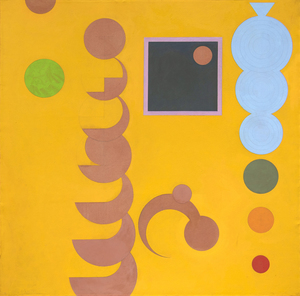Hassel Wendell Smith emerged as an artist and teacher in post-war San Francisco, the most exhilarating place outside of New York to paint and imagine what art could be. A force of brilliant intellect and puckish wit, he proved to be among the most willful participants in the great adventure of those years when in America, artists embarked on an impassioned inquiry, “whither shall art go?” He was hired in 1945 to teach at the California School of Fine Art alongside Clyfford Still, David Park, and Elmer Bischoff, the central figures that formed the nucleus of the West Coast contingent of first-generation Abstract Expressionists. Smith would prove the most maverick-driven among them and a singular, if honorary, member of the West Coast “Cool School” fraternity that consociated with the Ferus gallery in Los Angeles. Of the group — hard-living, hard-drinking and hell-bent on reinventing art as they went along — Hassel Smith was, as Ed Moses tells it, “the daddy of us all.”
Starting in the 1970s, Hassel Smith embarked on what proved to be his most protracted investigation into such matters. “Measured works,” he called them, are an open, yet unapologetic confession to using the tools of draftsmanship and precision: the ruler, compass and protractor. Yet there is little here that is “hard-edged” or Op Art in the way we understand those referential labels. Smith makes certain that his works avoid what he derisively referred to as “paintings of prisons, cells, and walls.” Instead, his surface values strive to be painterly. Their colors are, as Allan Temko described, “deceptively bland —but in fact biting — café-au-lait, muted blues and green, pink and reddish orange.”
There is an idea that the measured works come packed with some kind of mysterious code that might unlock their secrets. The reality is that they are no more private or excusive than a ballet performance. We see or conjure up relationships both formal and spatial and look for a system, but if there is a system at work, it is not an obvious one. Accept instead the elegance of the work. For an artist known for his wild streak, here, Smith shows remarkable restraint. Eventually, the series evolved and reached its conclusion in 1986 and ‘87 so that finally the forms begin to dissolve, their edges increasingly overwhelmed by brushstrokes; a momentary pause before he would launch into works of pure, energetic plumes and flickering gestures untethered and free.
Heather James is honored to present the estate of paintings by Hassel Smith, the artist that prompted “Art in America” to ask, “where is the major survey this fascinating artist deserves?”


